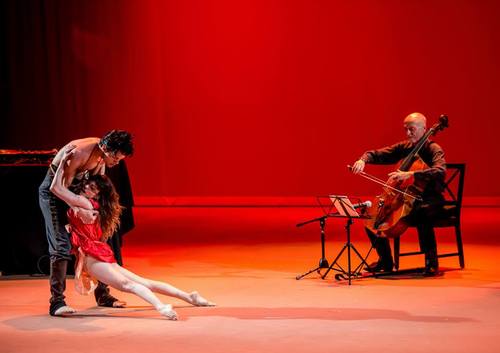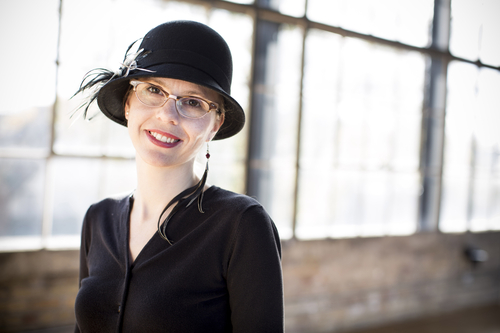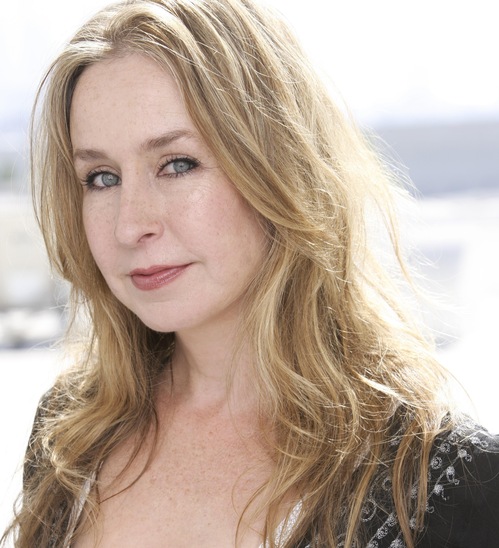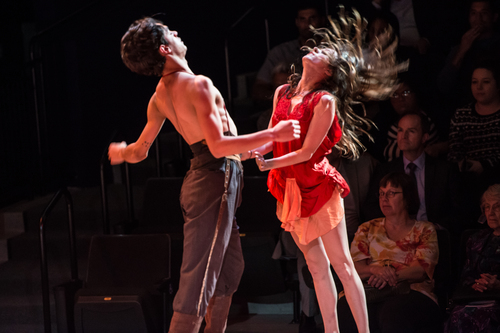| « The Amazing Spider-Man 2, Fading Gigolo, Locke, Blue Ruin & NOW: In the Wings on a World Stage | New Spring Exhibition at Stairway Studios » |
Preview Sat May 03 2014
MusicNOW: An Exploration of Fits + Starts
The Chicago Symphony Orchestra's MusicNOW series is not your typical performance experience. Upon entering the venue, guests are greeted with a DJ set. The performance itself is interactive, visionary, and one-of-a-kind, mixing media together to form a sensory whirlwind of an exquisite foray into the world of live performance. After the performance, guests are once again greeted with a DJ set, at a reception where they can mingle with the artists themselves.
Re-envisioning the concept of a live performance to make it more of a deliberately-crafted experience overall, one that is more intimate and personal, is what the MusicNOW series has made it a point to achieve. CSO Mead composers-in-residence Anna Clyne and Mason Bates have curated each performance with fervor and brilliance, featuring musicians from the Chicago Symphony Orchestra and guest musicians, as well. Monday, May 5 marks the final installment of the MusicNOW series for the 2013/2014 season, featuring a glorious lineup of three works paired nicely amongst the other, each contrasting yet fitting into a cohesive whole.
MusicNOW: Companions is set to showcase The Companion Guide to Rome, a musical tour through nine Roman churches, Fits + Starts, a more modern piece created by renowned composer Anna Clyne and acclaimed choreographer Kitty McNamee, and a chamber concerto, Livre des Sauvages. I was overjoyed to get the chance to speak with both Clyne and McNamee about their piece Fits + Starts exclusively, who allowed me to gain great insight into their creative processes and their hopes for viewers throughout the performance experience.
Anna Clyne is a London-born composer, now a CSO Mead in-residence composer through the 2014/2015 season. She has created a range of exquisite works, from Fits + Starts, to collaborative piece The Violin, to pieces composed for performances at Carnegie Hall, for the London Philharmonic Orchestra, and the Houston Ballet, to name just a few. Her work is touted as inventive and unique, as it blends ingenuity with a true musical talent.
The music for this piece is very modern -- how does this experience for you differ from the traditional?
As a composer, I need to have a different concept with the music and have it be very driven by Kitty's choreography. In terms of the music, I'm actually used to writing this style of music, which combines recorded electronics and live elements. What's interesting in terms of the cello with a full orchestra piece, is in essence we're changing the sound, it's actually just a few elements that I've woven together and spliced and re-pieced together. And then with the cello part, it's adding the extra layer that gives it more direction. The process translates really well for orchestral music because in a sense you have these huge parts of sound, it's not the same challenges and the enjoyment of the process is essentially changing the sound to be on a smaller level with a big orchestra, but the same process applies to both. The sound is different from the live acoustic orchestra; you still have to transplant rhythm and melody, so it is the same tools, but found in a different context.
Was the piece written in tandem with Kitty's choreography or was it written first?
I couldn't be more fortunate as a composer to come across this collaboration. It's quite rare where you have an artistic relationship where you trust the other partner 100% and that's the case with Kitty. So then knowing her language, going into Fits + Starts it felt very much like an organic, natural process. It was very much like a dialogue. It is a part of a larger work titled Victorian. We wanted to evoke a sense of the old within the new. For me, that very quickly was the sound of the harpsichords which had this sense of time which is disjointed from today but through the fabric of the tape you could bring the sounds to today. Using those harpsichords, I knew there were things that kitty could pull away from the music to frame the work choreographically. As I was writing it I would send sections and get her feedback and having her sense of trust made that very easy and natural.
Harpsichord, cello, viola and amplified cello is an interesting dynamic. What are the feelings and sensations you hope to create with this instrumental balance?
For the piece, something that immediately captivated me about Kitty's work is this sense of strong gesture that can be used, but a deep sense of sensuality and brooding darkness as the underbelly of the work. For in terms of what sounds I associated with that, I felt immediately that the harpsichord was the central idea. It gave me a sense of time and place but also a striking core motif that would be great choreographically. I like to limit the material; when you're doing a time-based art form you need to limit your material. In terms of recorded material, I recorded these elements and reconstructed them. So then the cello is a very sensual, visceral sound, especially when it's layered between the plucking of viola, and the nature of the harpsichord. I thought that would be a nice balanced palate.
Where did you draw influences from for the piece? Was it from classical influences combined with modern, or all modern work?
My work is nearly always collaborative and inspired by others in the filed or specific musicians I'm working with, and there's something about choreography with dance that I am passionate about and it comes back to the physicality of the human body and of music. From Fits + Starts when you hear it from a recording, it's very different from the live cellist. That's something that's always been really central to my composing. I built a really strong relationship between music and time.
What do you hope that the audience will take away from the music and performance?
I think it's not about one individual piece, but the entire concert, and that's something that I've spent a lot of time developing and ultimately, re-imagining the concert experience. For example, a DJ experience is present as you are entering the space. We take a very cinematic approach to this concert experience. We have short videos of each composer in their work space so it's up close and personal dialogue from the composer and you get more information about the piece itself. We have three very different works on the program. It is a journey between three very different sounds, then a concert party with a live DJ and musicians. So in terms of what they'll take away, it's just the overall experience of coming to music concerts. The musicians of the CSO are some of the best in the world to hear their commitment to contemporary music. Brant Talyor is the cellist performing, and he's the cellist in the CSO so it's a great opportunity for the audience to see the musicians in a very different context, and you're able to meet the musicians after the concerts.
Kitty McNamee, LA resident choreographer, produces work for Hysteria Dance Co. as their artistic director. Involved in a myriad of projects, she produces work for television, film, and live performances. She has developed choreography for artists such as Laura Marling, Julianne Hough, and Lily Tomlin, among others. Her work is known as energized and influential as she creates choreography for a variety of performance avenues.
From your perspective, how does your performance differ from the traditional?
We started the company when we started doing concert work, and we would do pretty traditional work, but as my work has changed and I've worked more commercially. It's kind of exploded where I've done show work and it's pretty insane where I've been going lately. Last May, the company performed at the Getty Center as part of a festival, which was was amazing. I've been working more and more as a commercial choreographer and incorporating the company in those jobs so we're trying to get the finer aspect into all aspects of my work.
The work is seemingly very unique in its production styles and instrumental layering. What emotions are you attempting to convey with the dancer choreography?
Well, the piece is called Fits + Starts, and it's really partly about relationships and how they go through fits and starts. It'll surge ahead, and then It will grind to a halt where you try to connect with somebody and you get pulled back, and it's those fits and starts. I'm very interested in everyone accessing dance and having it not be something that people find to be mysterious or inaccessible, so I always go for the more personal and more humanistic side of the story.
What has the process been like collaborating with Anna? This is not your first collaboration together.
Well, this piece she wrote for me, and in the process of creating it we went back and forth. She would send me the score and I would give her feedback on what I was working on and adjust, so we really did it together, and that is a gift. I would say that my work with Anna is the most collaborative I've ever experienced with a composer. We're really in sync, our ideas are similar and our musicality and our instincts are very similar so it's very fluid. And that's not always the case.
Where did you draw influences from for the choreography of the piece?
For that piece and you can hear in the music as well, I was thinking about this collision between our modern culture and Victorian culture. Visually Victorian, but the feeling and passion underneath that, so definitely the collision between Victorian and contemporary.
What types of dance would this most resemble to the viewer, if they were to anticipate certain styles of dance?
I would say contemporary, but there's definitely a lot of ballet in it.
What works have you previously choreographed, and how does this work compare?
I used to do full evening-length pieces, and as I began to work more and get more choreography jobs, my work in concert dance pieces got shorter, and more precise and condensed.
What is the central message of the piece and what effect do you think the piece will have on its audience?
What is really critical for me and why I love doing this kind of event is that you have to have the live music and live dance together. Part of Anna's music is recorded, combined with the live cello, and that experience of having both of those elements live is very exciting in a way that technology can't provide by watching something on TV. Seeing the people there right in front of you as it unfolds in the moment is pretty spectacular. Anna wrote it for me and for dance, and to have it done together, I think it's really magical. It's not the quite the same when it's just a recording. It's not quite the same if it's just dance. It's the two together that really makes it.
Tickets for MusicNOW: Companion can be purchased by phone at 312-294-3000, online, or by visiting the box office at 200 S. Michigan Ave. Discounted student tickets can be purchased subject to availability. The show begins at 7pm at the Harris Theater for Music and Dance at 205 E. Randolph Dr.












